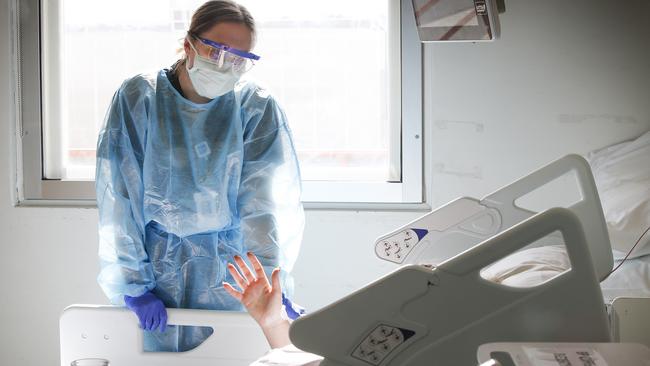
The surfboard, a nine-footer, was leaning against a wall, between the lounge room and the kitchen.
The son’s Canadian girlfriend, who is isolating with us, had offered to make honey and yoghurt smoothies for breakfast, in the new NutriBullet, which we bought in the hope of staying fit during the crisis. The NutriBullet, we discovered upon turning it on, makes a great whirring sound, and so naturally we were all dancing along as it did its thing, except I danced straight into the surfboard fin, which may as well have been the exposed blade of a circular saw for the damage it did.
A slobbery, gaping hole opened on my leg. The son came running from the Zoom lecture he’d been attending in the spare bedroom. He gave the wound a squirt with saltwater and, together, we debated whether to go to hospital and decided no.
Because we are in the middle a pandemic, right?
Meaning the emergency room would likely to be packed, and the doctors and nurses panicked, or at least with enough to do without a plonker from Bondi rolling through the door with an indoor surfing accident.
And so we iced the wound with a frozen block from the meal prep kit we’d had delivered earlier in the week, wrapped it in a bandage, and let it fester. Six or seven hours later I decided to walk to the shops, and that’s when the flesh finally gave way and, honestly, it was like when a frog opens up its wet and sinewy mouth, just ugh.
And so to hospital we finally went. My local, as it were, is the Prince of Wales in the Sydney suburb of Randwick. I expected, upon presenting at emergency, to have to wait but instead they seemed really pleased to see me.
Look, a patient! Come on in.
And from there, it was straight into emergency, and straight on to the ward, and this was precisely how things were not meant to be, remember? Mid-May, we were meant to be deeply into the mourning for the tens of thousands of lives lost.
On March 20, in this newspaper, my colleague Peter van Onselen wrote: “Experts … say that the virus could easily infect between five million and 15 million Australians … doing the best-case maths on the mortality rate to follow, (this) would mean 35,000-105,000 Australians will die from the coronavirus.”
It’s those figures that explain why Scott Morrison locked the country down. They explain everything.
This was a fast-moving disaster. Hospital staff were urged to brace, and brace they did, coming back to work for retraining in great numbers.
Ventilators and emergency equipment were secured, or else fashioned from what anyone could find. St Vincent’s Hospital in Sydney made plans to entirely clear the public intensive care unit so it could be dedicated to keeping coronavirus patients alive.
And then, for weeks, it was like the eerie calm before a tsunami, when all the water has been sucked out and everyone’s waiting for the wave to hit. And it did not come.
Instead, we’ve seen the Northern Territory’s Chief Health Officer grooving in a departmental hallway to Stayin’ Alive. The infection rate has flattened. The death rate has not soared.
There are not 60,000, or 70,000 or 90,000 dead. Hospitals did not have to deal with bodies piled up in the corridors.
At the same time, they are not dealing with the usual run of weekend sports injuries because there has been no weekend sport. There have been fewer car accidents because there’s nobody on the roads.
The staff are seeing more burns, from people courageously trying to make sourdough, but otherwise it’s been quiet and the atmosphere on the ward, well, it was best described as sheer relief.
They’ve all been so worried. And then the worst didn’t happen. So, I got my green sticker — no temperature — from the nurse on reception and I had my wound examined by a young doctor with silicon gloves and a blue face mask.
By chance, he was also a Bondi surfer, familiar with fin cuts, although “rarely in the kitchen”. He unwound the bandage we’d applied, reeled back and said: “You said you’ve been walking on that? Impressive!” which made me feel like the mother of all bad-ass surfer mums.
He did a quick X-ray, because they were worried the fin had chipped the bone, but it was fine. So then, to stitches.
They give you a local anaesthetic, so you can’t feel the needle, but you can still feel them tugging, can’t you? Uh-huh. You can.
Then it was into the wheelchair and home again, but before I left, I heard from one of the nurses that Scott Morrison wanted to give all Australians a “gold star” for the way they’ve managed this crisis.
“Maybe he’ll be like Hawkie, and say we all deserve a public holiday,” she said.
Then she paused and added: “Except that’s probably the last thing people want. Another bloody day at home.”
And everyone chuckled, and it was just so good to see, all those doctors and nurses standing around, relaxed and happy, in the time of COVID. Because we all did a great job. And they are all so grateful.








So, I think I could maybe win a prize for the daftest iso injury, having been admitted to hospital last Friday following a surfing accident. Key detail: it happened in the lounge room. The admissions note explains it best: “Patient was dancing in her apartment when impaled on the fin of son’s surfboard …” Yes, that happened.